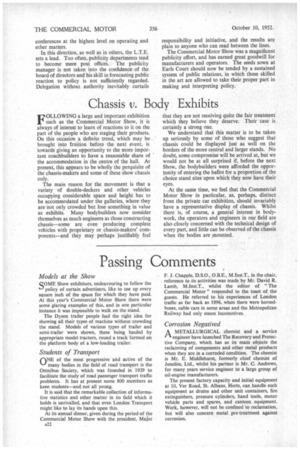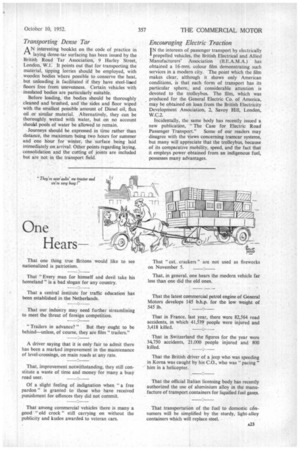Passing Comments
Page 24

Page 25

If you've noticed an error in this article please click here to report it so we can fix it.
Models at the Show
SOME Show exhibitors, endeavouring to follow the policy of certain advertisers, like to use up every square inch of the space for which they have paid. At this year's Commercial Motor Show there were some glaring examples of this, and in one particular instance it was impossible to walk on the stand.
The Dyson trailer people had the right idea for showing all their types of machine without crowding the stand. Models of various types of trailer and semi-trailer were shown, these being hauled by appropriate model tractors, round a track formed on the platform body of a low-loading trailer.
Students of Transport
riNE of the most progressive and active of the many bodies in .the field of road transport is the Omnibus Society, which was founded in 1929 to facilitate the study of road passenger transport traffic problems. It has at present some 800 members as keen students—and not all young.
It is said that the remarkable collection of informative statistics and other matter in its field which it holds is unrivalled, and that even London Transport might like to lay its hands upon this.
At its annual dinner, given during the period of the Commercial Motor Show with the president, Maier s22 F. J. Chapple, D.S.O., 0.B.E., M.Inst.T., in the chair, reference to its activities was made by Mr. David R. Lamb, Minst.T., whilst the editor of "The Commercial Motor" responded to the toast of the guests. He referred to his experiences of London traffic as far back as 1896, when there were horsedbuses, cable cars in some areas and the Metropolitan Railway had only steam locomotives.
Corrosion Negatived
AMETALLURGICAL chemist and a service engineer have launched The Recovery and Protective Company, which has as its main objects the reclaiming of components and other metal products when they are in a corroded condition. The chemist is Mr. E. Middlehurst, formerly chief chemist of Ienolite, Ltd., whilst his partner is Mr. C. Andrews, for many years service engineer to a large group of oil-engine manufacturers.
The present factory capacity and initial equipment at 10, Ver Road, St. Albans, Herts, can handle such equipment as drums and other unit containers, fire extinguishers, pressure cylinders, hand tools, motor vehicle parts and spares, and canteen equipment. Work, however, will not be confined to reclamation, but will also concern metal pre-treatment against corrosion.
Transporting Dense Tar
A N interesting booklet on the code of practice in
laying dense-tar surfacing has been issued by the British Road Tar Association, 9 Harley Street, London, W.1. It points out that for transporting the material, tipping lorries should be employed, with wooden bodies where possible to conserve the heat, but unloading is facilitated if they have steel-limed floors free from unevenness. Certain vehicles with insulated bodies are particularly suitable.
Before loading, the bodies should be thoroughly cleaned and brushed, and the sides and floor wiped with the smallest possible amount of Diesel oil, flux oil or similar material. Alternatively, they can be thoroughly wetted with water, but on no account should pools of water be allowed to remain.
Journeys should be expressed in time rather than distance, the maximum being two hours for summer and one Hour for winter, the surface being laid immediately on arrival. Other points regarding laying, consolidation and the cutting of joints are included but are not in the transport field.
Encouraging Electric Traction
IN the interests of passenger transport by electrically propelled vehicles, the British Electrical and Allied Manufacturers' Association (B.E.A.M.A.) has obtained a 16-mm. colour film demonstrating such services in a modern city. " The point which the film makes clear, although it shows only American conditions, is that each form of transport has its particular sphere, and considerable attention is devoted to the trolleybus. The film, which was produced for the General Electric Co. of America, may be obtained on loan from the British Electricity Development Association, 2, Savoy Hill, London, W.C.2.
Incidentally, the same body has recently issued a new publication, "The Case for Electric Road Passenger Transport." Some of our readers may disagree with the views concerning tramcar systems, but many will appreciate that the trolleybus, because of its comparative mobility, speed, and the fact that it employs power obtained from an indigenous fuel, possesses many advantages.












































































